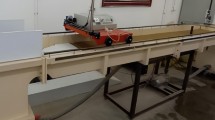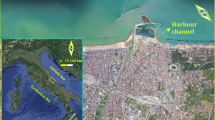Abstract
Debris flow initiation by channel bed mobilization is a common process in high mountainous areas. Initiation is more likely to occur at the outlet of small, steeply sloping basins where concentrated overland flow feeds an ephemeral channel incised in slope deposits. Such geological conditions are typical of the Dolomite region (Italian Alps), which is characterized by widespread debris flow activity triggered by severe summer thunderstorms. Real-time data and field observations for one of these catchments (Acquabona catchment, Belluno, Italian Alps) were used to characterize the hydrological response of the initiation area to rainfalls of varying intensity and duration. The observed behaviour was then reproduced by means of a simple hydrological model, based on the kinematic wave assumption, to simulate the generation of channel runoff. The model is capable of predicting the observed hydrological response for a wide range of rainfall impulses, thus providing a physical basis for the understanding of the debris flow triggering threshold.













Similar content being viewed by others
References
Anderson SA, Sitar N (1995) Analysis of rainfall-induced debris flows. J Geotech Eng 544–552
Armanini A, Gregoretti C (2000) Triggering of debris flow by overland flow: a comparison between theoretical and experimental results. In: Wiezczorek, Naeser (eds) Proc 2nd Int Conf on Debris flow hazards mitigation, Taipei, August 2000:117–124
Bagato A, Dalla Fontana G, Gregoretti C (2004) Analisi del verificarsi di condizioni di innesco di colate detritiche per mobilitazione di depositi detritici al fondo di canali naturali. Atti XXIX Conv. Idraulica, Trento, Italy, 256–264. Alessandro Bagato, Giancarlo Dalla Fontana e Carlo Gregoretti
Bathurst JC, Graf WH, Cao HH (1987) Bed load discharge equations for steep mountain river. In: Thorne CR, Bathurst JC, Hey R (eds) Sediment Transport in Gravel-Bed Rivers. Wiley
Berti M, Genevois R, Simoni A Tecca PR (1999) Field observations of a debris flow event in the Dolomites. Geomorphology. Elsevier, Amsterdam 29:265–274
Berti M, Genevois R, LaHusen R, Simoni A, Tecca PR (2000) Debris flow monitoring in the Acquabona watershed (Dolomites, Italian Alps). Physics and Chemistry of The Earth, Part B: Hydrology. Oceans Atmos 25(9):707–715
Beven KJ (1981) Kinematic subsurface stormflow. Water Resour Res 17:1419–1424
Buffington JM, Montgomery DR, (1997) A systematic analyses of eight decades of incipient motion studies, with special reference to gravel-bedded rivers. Water Resour Res 33(8):1993–2029
Bunte K, Abt SR (2001) Sampling surface and sub-surface particle-size distributions in wadable gravel- and cobble-bed streams for analysis in sediment transport, hydraulics, and stream bed monitoring. Gem Tech Rep RMRS-GTR-74, Fort Collins, CO: US Department of Agriculture, Forest Service, Rocky Mountain Research Station: 428 p
Campbell RH (1975) Soil slips, debris flows, and rainstorms in the Santa Monica Mountains and vicinity, Southern California. U S Geological Survey Professional Paper no 851:51 pp
Cannon SH, Ellen SD (1988) Rainfall that resulted in abundant debris-flow activity during the storm. USGS Prof Paper 1434:27–33
Cannon SH, Gartner JE, Parrett C, Parise M (2003) Wildfire-related debris flow generation through episodic progressive sediment bulking processes, western USA. In: Rickenmann D, Chen CL (eds) Proceedings of the Third International Conference on Debris-Flow Hazards Mitigation. Davos, Switzerland, pp 71–82
Chiew YM, Parker G (1994) Incipient sediment motion on non horizontal slopes. J Hyd Res 32(5):649–660
Chow VT (1959) Open channel hydraulics. McGraw-Hill
Chow VT, Maidment DR, Mays W (1988) Applied hydrology. McGraw-Hill
Coe JA, Godt JW, Parise M, Moscariello A (2003) Estimating debris-flow probability using fan stratigraphy, historic records, and drainage-basin morphology, Interstate 70 highway corridor, central Colorado, USA. In: Rickenmann D, Chen C (eds) Proc 3rd Int Conf on Debris Flow Hazard Mitigation: Mechanics, Prediction, and Assessment, Davos 2:1085–1096
Conedera M, Peter L, Marxer P, Forster, Rickenmann D, Re L (2003) Consequences of forest fires on the hydrogeological response of mountain catchments: a case study of the Riale Buffaga, Ticino, Switzerland. Earth Surf Process Landf 28:117–129
D’Agostino V, Marchi L (2003) Geomorphological estimation of debris flow volumes in alpine basins. In: Rickenmann D, Chen C (eds) Proc 3rd Int Conf on Debris Flow Hazard Mitigation: Mechanics, Prediction, and Assessment, Davos, 2:1097–1106
Eagleson P (1970) Dynamic hydrology. McGraw-Hill
Ellen SD (1988) Description and mechanics of soil slip/debris flows in the storm. USGS Professional Paper 1434:63–113
Fetter CW (1980) Applied hydrogeology. Charles E. Merrill Publishing Company Co, Columbus, Ohio
Genevois R, Berti M, Ghirotti M, Simoni A, Tecca PR Debris flow monitoring and analysis in the Dolomitic Region (Upper Boite Valley, Italian Alps). CEE project “Debris flow risk” Final Scientific Report, contract n ENV4CT960253, 2: p 58
Genevois R, Tecca PR, Berti M, Simoni A (2000a) Pore pressure distribution in the initiation area of a granular debris flow. In: Bromhead E, Dixon N, Ibsen ML (eds) Proceedings of the 8th International Symposium on Landslides. Cardiff 12:615–620
Genevois R, Tecca PR, Berti M, Simoni A (2000b) Debris flows in Dolomites: experimental data from a monitoring system. In: Wieczoreck GF (ed) Proceedings Second International Conference on Debris Flow Hazards Mitigation: Mechanics, Prediction and Assessment, Taipei 283–292
Gregoretti C (2000) The initiation of debris flow at high slopes: experimental results. J Hyd Res 38(2):83–88
Griffiths PG, Webb RH, Melis TS (1997) Initiation of debris flows in tributaries of the Colorado River in Grand Canyon, Arizona. Chen C (ed) Proceedings First International Conference on Debris Flow Hazards Mitigation: Mechanics, Prediction and Assessment 12–20
Iverson RM (1990) Groundwater flow fields infinite slopes. Geotechnique 40:139–43
Lamberti A, Genevois R, Berti M, Orlandini S, Papa M, Simoni A, Tecca PR (1999) Tentative risk map of the area of Cortina d’Ampezzo (Eastern Alps, Italy). EU project “Debris flow risk” final scientific report, contract n ENV4CT960253, 2:20 pp
Lighthill MJ, Whitham JB (1955) On kinematic waves. I: Flow movement in long river; II: A theory of traffic flow in long crowed roads. Proc Royal Soc A 229:281–345
Martin DA, Moody JA (2001) Comparison of soil infiltration rates in burned and unburned mountainous watersheds. Hydrol Process 15:2893–2903
Montgomery DR, Dietrich WE (1994) A physically based model for the topographic control on shallow landsliding. Water Reseour Res 30(4):1153–1171
Orlandini S, Lamberti A (2000) Effect of wind on precipitation intercepted by steep mountain slopes. J Hydrol Eng Am Soc Civ Eng 5:346–354
Pack RT, Tarboton DG, Goodwin CN (1998) Terrain stability mapping with SINMAP, technical description and users guide for version 1.00. Terratech Consulting Ltd, Salmon Arm, BC, Canada, Report Number 4114-0:68pp
Panday S, Huyakorn PS (2004) A fully coupled physically-based spatially-distributed model for evaluating surface/subsurface flow. Adv Water Resour 27:361–382
Panizza M, Pasuto A, Silvano S, Soldati M (1996) Temporal occurrence and activity of landslides in the area of Cortina d’Ampezzo (Dolomites, Italy). Geomorphology 15:311–326
Sidle RC, Swanston DN (1982) Analysis of a small debris slide in coastal Alaska. Can Geotech J 19(2):167–174
Richards LA (1931) Capillary conduction of liquids through porous media. Physics 1:318–333
Serrano SE (2004) Modelling Infiltration with Approximate Solutions to Richard’s Equation. J Hydrol Eng 9(5):421–432
Soil Conservation Service (1986) Urban hydrology for small watersheds. Technical Release 55 USDA, Springfield, VA
Takahashi T (1991) Debris Flow. IAHR Monograph Balkema, Rotterdam
Takahashi T (2000) Initiation and flow of various types of debris flow. In: Wieczoreck GF (ed) Proceedings Second International Conference on Debris Flow Hazards Mitigation: Mechanics, Prediction and Assessment, Taipei: 15–25
Tan TS, Phoon KK, Chong PC (2004) Numerical Study of Finite Element Method Based Solutions for Propagation of Wetting Fronts in Unsaturated Soil. J Geotech Geoenviron Eng 130(3):254–263
Tognacca C, Bezzola GR (1997) Debris flow initiation by channel-bed failure. Chen C. (ed) Proceedings First International Conference on Debris Flow Hazards Mitigation: Mechanics, Prediction and Assessment: 44–53
Tognacca C, Bezzola GR, Minor HE (2000) Threshold criterion for debris-flow initiation due to channel bed failure. In: Wieczoreck GF (ed) Proceedings Second International Conference on Debris Flow Hazards Mitigation: Mechanics, Prediction and Assessment, Taipei: 89–97
USACE (1994) Flood-runoff analysis. EM 1110-2-1417 Office of Chief of Engineers, Washington, DC
USACE (2000) Hydrologic Modelling System HEC-HMS. Technical Reference Manual. Office of Chief of Engineers, Washington, DC
Wieczorek GF (1987) Effects of Rainfall Intensity and Duration on Debris Flows in Central Santa Cruz Mountains, California. In: Wieczorek GF, Costa, JE (eds), Debris Flows/Avalanches; Process, Recognition, and Mitigation. Geologic Society of America, Reviews in Engineering Geology, VII:93–104
Wieczorek GF, Morgan BA, Campbell RH (2000) Debris-flow hazards in the Blue Ridge of central Virginia. Environ Eng Geosci 6(1):3–23
Acknowledgements
The research was funded by grant from the Ministero dell’Istruzione, dell’Università e della Ricerca, Project title “Analisi integrata di casi scelti di colate detritiche nell’arco alpino” (A.Lamberti coord.), years 2003–2005. Thanks to Richard LaHusen (USGS, Cascade Volcanoes Observatory, WA-USA) who installed the monitoring system at Acquabona in late 1997 and to Rinaldo Genevois, who coordinated that monitoring project and introduced us to the fascinating subject of debris flows. Finally, we would like to thank the reviewers for their useful remarks
Author information
Authors and Affiliations
Corresponding author
Rights and permissions
About this article
Cite this article
Berti, M., Simoni, A. Experimental evidences and numerical modelling of debris flow initiated by channel runoff. Landslides 2, 171–182 (2005). https://doi.org/10.1007/s10346-005-0062-4
Received:
Accepted:
Published:
Issue Date:
DOI: https://doi.org/10.1007/s10346-005-0062-4




